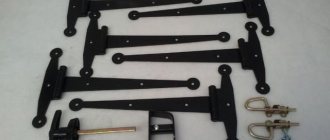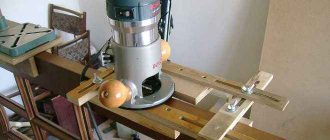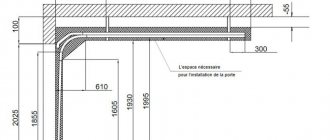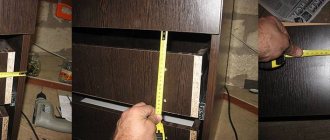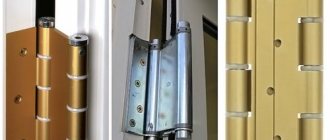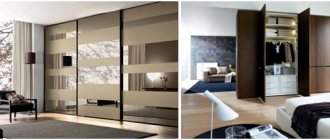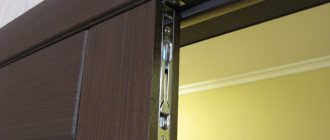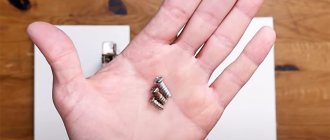Buyers about furniture "
Some furniture manufacturers try not to think about their customers. They live by the principle: “The client comes and goes, but you always want to eat.” The rustle of banknotes has become the most desirable music for these producers, making their souls feel warm and calm. Greedy furniture makers save where they can and where they can’t. They produce a low-quality product, which within a month begins to cause a lot of trouble for the client, bringing him to tears and despair. Furniture makers sleep peacefully and don’t flinch at night. But in vain...
The topic of our conversation today will be: installation of furniture hinges . Don’t be alarmed, I won’t teach you how to drill holes for hinges or delve into the craftsmanship of assembling furniture. I think this should be done by specialists. But, you must admit, you have the right to know what negligent furniture manufacturers can “cheat” you on. And now you will find out about it! We will ruin the sleep of hacks and slobs! They will finally start to shudder at night and realize that:
Money is important, but the client is much more important than money!
Many of you have had to deal with a situation where the doors of an almost new cabinet or cabinet simply warp under their own weight. Moreover, this does not happen a year or two after purchasing the furniture, but literally a month and a half later. What is the reason? Why do hinges not withstand loads and sag under the weight of furniture doors?
And it’s all very simple - the manufacturer of your furniture saved a little on the quality or quantity of hinges installed. Although, more often than not, such careless furniture makers save on both. Let's figure out why this happens and how you can resist the greed of the “hammer and screwdriver workers.”
Purpose of hinges for kitchen facades
First of all, hinges for furniture doors are needed to secure the facades to the body. They also make it possible to open and close swing doors. The possibility of adjusting the facades themselves (thick, radius), the degree of fixation of the doors, the maximum possible angle of the doors when opening, the smoothness of the free movement of the doors, the absence of creaks, distortions and other possible defects depends on which hinges will be selected.
Mounting device and features
The most popular model for the facades of kitchen cabinets are four-hinge hinges, popularly called “frogs”. This design is very durable, has the ability to adjust the position of the facade and a stopper to prevent arbitrary opening of the doors. You can read about the standard sizes of kitchen units in this material.
The production of four-hinged hinges occurs by stamping sheet metal (steel). The product is covered with a layer of galvanic coating on top, which provides an aesthetic appearance and protection against rusting (corrosion). They can also be covered with various decorative coatings, making the surface matte, chrome or colored.
Parts of a four-joint hinge:
- Cup. It has a square shape with rounded corners. Inserts into the hinge hole on the inside of the door. And it is attached using self-tapping screws; it is possible to use an additive.
- Shoulder. Four-joint mechanism that acts as a lever for opening/closing.
- Mounting plate required for installation. The hinge body is attached to the strike plate. Special screws can be used to adjust the position of the facade.
Additionally, the kit may include:
- Bowl covers.
- Shoulder pads.
- Closers (allow the hinge to close smoothly).
Types and sizes
- Invoices. When attaching the hinges to the facade in this way, it is completely closed on the side, eliminating gaps. When the door is closed, the angle between the facade and the side of the box is 90 degrees. When the door is open, this angle is 110 degrees. This fastening option is used in cases where it is necessary to cover the open part of the box with one or two doors.
- Semi-overhead. Such loops have a bend at their base. Installed on the facade, they cover half of the side of the box. The hinge angle when closed is 90 degrees, when open it is 110 degrees. They are used if there is a need to install hinges on one partition in order to open the doors in different directions (when installing overhead hinges, the doors will not be able to open).
- Deposits. They are installed inside the box and have a large bend at the base. When using these types of hinges, the sides of the box are visible. The hinge angle when closed is 90 degrees, when open it is 100 degrees. They can be attached to the sides of the box or to its partitions.
- Angular. Hinges are used for installation on corner drawers. In this case, the width of the side parts that are located next to the facade must be the same. The hinge angle when closed is 45 degrees, when open it is 95 degrees.
- Inverse. Installed when it is necessary to open the door completely. The angle of the hinge when open is 180 degrees, the facade is located on the same straight line with the sidewall of the box.
- Piano hinges are single-hinged. They are rarely used because without an additionally installed magnet the doors do not close completely. Most often they are mounted on furniture with a top-opening door.
- Card. The structure is similar to piano hinges: two hinge plates are mounted parallel to the hinge. Installed on retro style furniture.
- Mezzanine. Used when it is necessary to open the facade upwards. The principle of operation is similar to door closers, only the mezzanine ones have a spring installed, which allows the doors to smoothly open and close.
- Secret. They are arranged according to the principle of piano and card games. Installed on furniture whose doors open downwards.
- Ombre. Installed on folding facades. Often used to make kitchen folding tables.
- Pendulum (bar). Spring hinges, which are similar in structure to piano hinges. They ensure the opening of facades by 180 degrees (following the principle of fittings for bar counters in Mexican countries).
- Heel. They are used extremely rarely, because to install such hinges the door must be light in weight, mainly for small corner kitchens.
Types of furniture hinges, how to choose:
How to install on corner or non-standard furniture
As a rule, kitchen furniture doors are already ready for installing hinges, but if you need to install a non-standard door or install new hinges, then first you need to take measurements. You can find out about a rattan chair here.
To drill the hole for the bowl, you will need a Forstner drill bit. Also required for installation: calipers, drill and wood drill bit, screws, locking brackets.
First, we make markings on the door depending on the number of hinges required. We retreat 21 or 22 mm from the edge. In the designated places, use a pencil to mark the center of the future holes. Drill holes using a Forstner drill. The diameter of the hole for the bowl is 35 mm, depth 12 mm. Before you start drilling, you need to make sure that the drill will not go through.
Tips for installing hinges and closers
Depending on the size of the door, the number of hinges that need to be installed varies:
- Door length up to 90 cm, weight about 4 kg - 2 hinges.
- Length from 90 cm to 160 cm, weight up to 13 kg - 3 loops.
- Door length from 160 cm to 200 cm, weight up to 17 kg - 4 hinges.
- Length from 200 cm to 240 cm, weight up to 20 kg - 5 loops.
- When marking, the top and bottom hinges should be at a distance of 70 to 120 mm from the top and bottom edges of the door, respectively.
- When marking and placing hinges, you need to make sure that shelves and partitions will not be located in these places.
- Before starting installation, it is necessary to measure the thickness of the hinge so that it fits firmly into the drilled hole.
When installing internal hinges, markings are made from the inside of the door, taking into account the gap between the door and the frame of 2 mm.
Video: how to replace hinges on kitchen cabinet doors
Replacing the hinge on a cabinet door:
DIY repair
Over time, furniture hinges may fall out of their installation sockets. There is no need to immediately throw out the closet or change furniture fronts. First you need to remove the loop and carefully widen the hole (10 mm deep). Next, you need to lubricate the wooden dowel with wood glue (or PVA) and drive it into the resulting hole.
We do everything carefully so as not to pierce the material through. After the glue has completely dried, we cut off the protruding part of the dowel with a hacksaw. We tighten the screws that secure the loops directly into the dowels.
Scope of application
Furniture hinges 26 mm are designed for light facades. Fasteners are used for glass doors and compact cabinets. The fittings are designed for light weight. Small bedside tables in the bathroom or kitchen can be safely equipped with mini hinges. Interesting cabinets with glass doors are also best equipped with compact fittings. When using overlays, it is possible to hide the hinges and add aesthetics to the furniture.
You can install a hinge with a cup diameter of 26 mm with a closer. This will ensure mechanical closing and opening of the doors. Such fittings will cost more. The internal mechanism is equipped with a shock absorber. If you slam the door, there will be no characteristic knock. The closer ensures smooth closing.
Manufacturers of furniture fittings
Bloom furniture hinges, advantages and disadvantages:
- SCILM. An Italian company that produces high-quality furniture fittings and components, frame profiles, plinths and other products that are used in furniture production.
- Boyard. Ekaterinburg company supplying furniture fittings from China.
- "RosAks" . Moscow manufacturer of furniture fittings.
- VIBO . An Italian company, the largest manufacturer of accessories in its country.
- BLUM. Austrian manufacturer of fittings and solid wood furniture.
- FENNEL . For many years, the Ukrainian company has been a leader in the supply of furniture fittings to more than 60 countries.
- TBM. Domestic manufacturer of metal furniture fittings.
You can read more about the features and range of Blum fittings in our article.
Tips for choosing furniture fittings for the kitchen:
When choosing hinges for cabinet fronts and fillers, you need to pay attention to the following factors:
- Required opening angle and cabinet location.
- Type of lockers (corner, with doors opening up/down, etc.).
- Door weight and length.
- The quality of the metal from which the hinge is made (it is recommended to choose a brass-zinc alloy for covering furniture).
The hinges on the doors may not be the brightest detail of the kitchen façade, but they are one of the most important. After all, the comfortable and reliable use of a furniture set depends on the quality of cabinet fittings. See also information about handles for kitchen furniture here.
Marking, adding and adjusting furniture hinges on cabinet doors in examples
There are a large number of types of furniture hinges on the modern furniture fittings market. In modern furniture production, four-hinged modifications are most often used, which are improved hinges from the times of the USSR. Of course, today's hinges are much more reliable and better quality than their predecessors. Today, the choice of components for making furniture is quite extensive.
Let's figure out what types of hinges are used by furniture makers today in the manufacture of furniture.
The most commonly used hinges are overhead hinges, which are used mainly for attaching facades (doors) to the furniture body. There are also semi-overlay hinges, internal, corner, with closers, spring, etc.
Today we will look at installing an overhead type furniture hinge. I would like to note that the installation of all other types of canopies will be similar.
First, you need to figure out what parts the loop consists of. First of all, this is the mounting strip and the mechanism itself. The fastener bar should be mounted to the inside of the case, the loop should be mounted on the facade in a special hole, which must be made blind, twelve to thirteen millimeters deep.
The diameter of the hole depends on the type of loop, and can be twenty-six or thirty-five millimeters.
Canopies with a bowl of twenty-six millimeters are used extremely rarely.
Furniture makers use them only in cases where it is necessary to attach the facade to a module in which a washing machine is placed (non-built-in). This is explained by the fact that the gap for attaching the hinge in this case is very small, and it is not possible to attach a standard canopy.
Types and uses of card loops
These mounts get their name from a mechanism that consists of a rotating axis with cards rotating on it (also called wings). The cards are equipped with holes for self-tapping screws (nails). One of the cards is attached to the door jamb, the second - to the door leaf.
The diagram below shows the mechanism of a classic card loop.
Fixed canopy mechanism: 1 - rotary axis; 2 — decorative plug; 3 - bearings; 4 - map
Product classification
Card-type canopies differ, first of all, in the installation method: in the first case, they are simply screwed to the canvas with self-tapping screws and therefore are called overhead, and in the second, they are cut into its top layer, for which they are called mortise. In addition, hinges are classified according to the direction in which the door opens, and therefore they are:
- non-removable: selected depending on which way the door will open. Can be right or left. The main disadvantage of this type of awnings is that if it is necessary to remove the door, you will first have to dismantle the awnings by unscrewing all the screws.
Non-removable card canopy
Removable card canopy
Scope of use
Card fastenings are most often used when installing interior doors, street gates, and in utility and utility rooms. In this case, overhead-type hinges are usually installed on street-type doors, and mortise-type hinges are installed indoors. This is primarily due to aesthetic considerations: the mortise mechanisms on the door leaves are not noticeable, and therefore the doors look neat.
Card canopies are also used in furniture making. Mainly for wooden furniture in the “retro” style, as well as for furniture made by craftsmen with their own hands at home and who do not know how to install four-hinge furniture hinges. In factories, the card furniture hinge is practically not used, since it lacks the advantages of the above-mentioned hinge hinges.
Progress
Marking furniture hinges
First, you need to mark the centers of the future holes. Since all doors have different heights and intended installation locations, the figures for each option will vary from seventy to one hundred and twenty millimeters. One more point: depending on the weight of the door and its size, three or more canopies can be installed.
When installing three or more hinges on one facade, pay attention to ensure that the hinge does not end up on the horizontal internal parts of the cabinet (for example, shelves, drawer ends, etc.). Make a mark for the hole at a distance of twenty-two millimeters from the end of the door.
Drilling a hole for the bowl
Armed with a screwdriver and a 35mm end mill, start drilling. Basically, the depth of the bowls is twelve to thirteen millimeters. You should not try to drill deeper, because chipboard, which is only 16 millimeters thick, does not always have high-quality outer laminate layers. If you drill a slightly larger hole, there is a risk of damaging these layers, which, unfortunately, will be impossible to mask or repair.
It is recommended to use a well-sharpened cutter, with which it will be impossible to damage the surface or make chips. Also, to avoid chipping, the screwdriver should be held strictly vertically.
Installation of overhead hinges. Insert the loop into the resulting hole, align it with the end of the facade.
Use an awl to make marks for the screws. Then screw them into the holes.
Hanging the facade
Attach a pad for attaching a hinge to the inner side of the case. Connect the two parts of the canopy. Adjust the front to the body using a screwdriver.
It is very convenient to do this NOT in weight, but just on a flat surface in a horizontal position. Those. the sidewall on which you need to attach the hinge pad should be in a horizontal position, so you can easily try on and screw the facade to the sidewall.
Chipboard cabinet door repair
The most common problem with such parts is that screws, screws or self-tapping screws fly out, often together with pieces of the board. A hole is formed into which nothing can be inserted. How to repair a chipboard cabinet door if such a disaster occurs?
In several ways:
- install a loop of a different design;
- seal the holes using a special proprietary composition;
- seal the holes with a homemade solution of sawdust and glue;
- placing wooden bushings;
- placing a wooden or metal die.
Glue and screws
The chipboard from which furniture is made can be either hard or soft. Repair methods in these cases will be different. For example, if the cabinet is made of soft board (as a rule, modern furniture is made from this), you can repair broken holes using sawdust, but this option is not suitable for old Soviet furniture.
If the fastener has come off and a “lacerated wound” has formed in its place, you can try to repair it with a composition that includes:
- sawdust;
- PVA glue.
In this case, it is not necessary to remove the door from the second hinge:
- Mix sawdust with glue to form a thick and relatively homogeneous mass (it is important that there are no large lumps).
- Seal the hole with this mixture.
- Let dry completely.
- Dip the screws in the same glue and screw them in.
Important! This method is only suitable for small cabinets whose doors are quite light.
Epoxy resin
This option is more reliable than the previous one, since the epoxy, after hardening, has quite high strength:
- Mix epoxy resin with large sawdust.
- Fill the damaged area.
- Allow to dry completely, which will take approximately 24 hours.
- Mark the locations of the holes for the fasteners - if you are not going to change the hinge, they will be located in the same place as they were.
- Drill holes with a thin drill bit.
- Drill them to the diameter of the screws.
- Secure the door.
If a large piece falls off
It also happens that a large piece of chipboard falls off at the fastening site, but does not fall apart into separate fragments. In this case, you can simply glue it by adding a small amount of sawdust to the PVA glue. The rest is done in the same way as in the previous case.
When the door just fell off
How to repair a cabinet door made of chipboard if it has fallen off, but quite neatly, and no sawdust has formed? In this case, plastic dowels will help you out.
You will also need a tool that can be used to trim the dowels - they will most likely turn out to be longer than necessary. The dowels should not come out. You can cut them with a knife. After you insert them, hang the door hinge on the screws.
Adjusting furniture hinges
As for the adjustment of furniture hinges, it can be carried out in three planes: vertically, in depth and fixing the canopy, horizontally.
1. Adjusting the hinges in depth and fixing the canopy is, first of all, necessary in order to press the facade closer to the body, or, conversely, to weaken this pressing. Use a screwdriver to tighten the oval hole. Very often, in this way, hinges are adjusted in rooms with uneven floors.
2. Vertical adjustment allows you to move the door higher or lower. Since facades, like everything else, are subject to gravity, they can sag over time. It is necessary to make such adjustments to the canopies from time to time. It is performed by the same twisting of the oval holes.
3. Horizontal adjustment. In other words, it is a side adjustment. Due to it, you can avoid gaps between the facades and the body part. This method is also good if the room has uneven floors or walls.
Well, now you know everything about attaching furniture hinges to a furniture façade. We hope our instructions will help you avoid the most common mistakes when installing furniture hinges yourself.
Types of loops and their design
Modern door and furniture hinges are classified according to a number of characteristics: design features, location and method of fastening, as well as material of manufacture.
Furniture
The most popular are furniture hinges, overhead hinges, inset hinges (internal), secret hinges, cupless hinges, four-hinged hinges, and also for specially designed facades. They are presented in the assortment not only of construction stores, but also of ordinary hardware stores.
Cupless: piano, card, pin
Cupless hinges are rarely used in furniture production. They are designed for installation of interior doors. You can find cupless hinges in Soviet-style furniture. Nowadays they play more of a decorative role and are used in the installation of secretory sheets and folding covers of book-tables.
Quadruple joint
In most cases, the hinged doors of modern furniture are mounted on four-hinged hinges. This allows you to adjust the tightness of the canvas to the furniture body, adjust the location of the door vertically and horizontally relative to the frame.
The four-hinged part consists of two parts connected to each other:
- mounting plate;
- bowls with knee.
Overhead hinges that do not require drilling of the facade
Installed when installation of ordinary four-hinged hinges is impossible. For example, if the thickness of the facade panel is insignificant.
Hinges for fastening specific facades
They are used if the aluminum frames of the prefabricated façade fabric have different widths. Parts are divided into internal and overhead. They are installed in corner cabinets, the front doors of which open to 45°, 135° and 180°.
Selecting and installing card loops
Door hinges (canopies) are produced today in a huge assortment, and according to the installation method they are divided into several types: overhead, mortise, double-sided, hidden, corner, screw-in and combined. The most popular in this series is the card loop, which can be mortise or overhead depending on the installation method.
Artistic card loop
Hinge Installation Instructions
To install the hinges correctly, you need to collect all the necessary materials and tools and follow the step-by-step instructions, observing the steps for installing furniture hinges.
Materials and tools
Before installing furniture hinges with your own hands, you need to remove the door leaf: first, unscrew the side of the door hinge adjacent to the structure, and then, from the already removed sash, remove the old one that is out of order. As a rule, furniture manufacturers use overhead hinges in the manufacture of products. With their help, the facades are fixed to the body.
The four-hinged model of overhead-type door hinges comes in different sizes and consists of the following parts:
- strips (connects the door and the cabinet body);
- mounting cup (which is attached to the facade of the canvas);
- shoulder (acts as the skeleton of the part).
For installation, in addition to a simple or black pencil and ruler, you will need the following tools:
Marking
At the next stage, it is necessary to accurately mark the future holes on the door leaf. They retreat from the edge of the façade slab by 8-12 cm, depending on the number of fasteners. The key condition is that the distance between the loops (and therefore the centers of the holes) should not exceed 50 cm, the minimum - at least 45-46 cm.
Hole preparation
The next stage is inserting furniture hinges. To do this, you can use a drill or screwdriver. You also need to install a wood cutter, this will eliminate chips and deformation of the facade surface.
Hinge Attachment
Loops are placed in the prepared holes. The correct position is corrected using a regular ruler, building level or tape measure. If the canopy does not fit tightly to the surface of the rear side of the facade, the door will also not close tightly, protruding obliquely along the edge.
Hanging a facade or door
Hanging the façade fabric is carried out in several stages:
- mark a place for mounting loop platforms;
- attach the platforms located on the facade, which will allow you to secure the door hinges;
- hang the façade panel to the side of the cabinet;
- Use a screwdriver to adjust the sash.
For convenience, it is recommended to hang the door on a flat surface to avoid distortions. Therefore, the cabinet should be placed on a horizontal surface so that the side to which the hanging strip is attached is parallel to the floor.
Adjustment
The final stage is adjustment vertically, horizontally and relative to the depth of the hole. To correctly adjust the mechanism, sometimes it is necessary to unscrew and screw the loops back several times, but a favorable outcome is guaranteed.
- Regarding the depth of the hole. This is especially true for rooms whose floors have an uneven surface. This will allow you to determine the degree of pressure of the front door to the body.
- Vertical adjustment involves tightening the oval holes to move the facade leaf relative to the height of the body.
- It is especially necessary to avoid horizontal adjustment in rooms with uneven walls and floors, which will avoid gaps and gaps between the facade and the body of the furniture.
Thus, installing furniture hinges on your own does not require specific skills and knowledge. The main thing is to follow the prescribed recommendations, then you will be able to avoid gaps and prevent the formation of cracks on the front part of the door panel.
Recommendations for selection
When choosing suitable hinges, you should focus on the following characteristics:
- door leaf weight;
- door opening direction;
- hinge mechanism used;
- operating conditions and door type;
- external fastening characteristics.
Let's look at each characteristic in more detail:
- Door leaf weight. Depending on the weight of the door, the number of hinges and their size are calculated. So, large card hinges for doors made of durable metals are placed on heavy panels, and small ones on lighter ones. When selecting loops, it is recommended to focus on the following diagram.
Door hinge selection diagram
- Door opening direction. When choosing permanent canopies, you should remember that they come in left and right versions. It is not difficult to determine which hinges are required: it all depends on which side the hinges will be on (if on the left, then the left ones are needed, and if on the right, then the right ones). It should be remembered that universal card hinges can be used on doors with any opening direction.
- Mechanism used. The simplest hinges consist of a pivot pin and two perforated cards. Better ones are equipped with bearings that improve the opening and closing of the door leaf. As a rule, they look more attractive. Some models may also be equipped with springs (closers), allowing the door to close on its own.
- Operating conditions and door type. Depending on the conditions under which the doors will be used, their type and stylistic design depend. The size of hinges for interior doors usually varies from 100 to 180 mm, and for windows and furniture - up to 100 mm.
- External characteristics. Due to the material used, as well as the shape of the decorative plug and the lower part of the rotary pin, a variety of products, their stylistic affiliation and artistic execution are achieved. Inexpensive card door hinges are made, as a rule, from ordinary stainless steel, higher quality products are made from alloys of non-ferrous metals, and the most expensive ones are made from high-quality steel.
Installation instructions
The installation of hinges depends on whether they are hinged or mortise. The sequence of actions when installing card loops is as follows:
- The location for placing the fasteners is determined: at least 275 mm from the bottom and 275 mm from the top when installing two hinges and 150 mm when installing three or more hinges. In this case, the third and fourth loops are usually placed at 1/3 level from the top or bottom of the fabric. To ensure a smooth ride, as well as for aesthetic purposes, the cards are placed at the end of the canvas.
- If the location for fastening is determined, you need to mark it with a marker, chalk or a simple pencil. To do this, the map is applied to the canvas and outlined.
- Then similar marks are made on the door frame.
Marking the location for the door hinge
- When installing overhead awnings, all that remains is to screw the cards using self-tapping screws to the canvas and door frame.
- If you are installing mortise hinges, you will additionally need to remove the top layer of the material from which the door is made. When forming grooves, the recesses are made with a chisel strictly along the lines drawn earlier.
